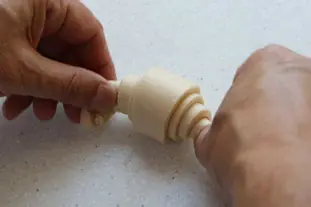French croissants
A recipe from cooking-ez.com June 26th 2019650 K 24.1
For 10 croissants, you will need:
- 1 750 g yeast-based flaky dough (for croissants)
- 2 30 g beaten egg
- Total weight: 780 grams
Times:
| Preparation | Resting | Cooking | Start to finish |
|---|---|---|---|
| 45 min. | 1 hour 30 min. | 20 min. | 2 hours 35 min. |
Step by step recipe
| 1 | Roll out 750 g yeast-based flaky dough (for croissants) really cold into a 10 inch (25 cm) wide strip. The length will depend on the number of croissant you are going to make. Ideally, it should be 0.2 inch (4 mm) thick. |  |
| 2 | Cutting outTo make the croissants, you need to cut the dough strip across into elongated triangles with a base of 3 inches (8 cm).There are 2 ways of doing this: either isoceles triangles, as shown here... |  |
| 3 | ...or right-angle triangles as in this diagram. Choose whichever method you prefer. The right-angle method is traditionally reckoned to be simpler. |  |
| 4 | I've opted for the isoceles method, but I'm using a template, cut from plastic, to help me. |  |
| 5 | Cut the whole strip of dough into triangles. Each triangle should ideally weigh 70 gr. Note: as with any viennoiseries, cold is your friend. Whenever you feel the dough starting to soften too much, declare a "cooling pause", transfer your triangles onto a baking sheet and leave in the freezer for 15 minutes to firm up. |  |
| 6 | There are 2 ways to shape the croissants: 1) "Straight", where the rolled-up croissants are not curved. This is the simpler method. 2) "Curved", where the finished croissants are crescent-shaped, and the dough is cut to achieve this curve. This is a trickier method. If you wish to make curved croissants, make a 1 inch (2 cm) cut in the middle of the base edge of each triangle. |  |
| 7 | Shaping straight croissantsTake a triangle of dough and stretch gently lengthways several times. It should increase from 10 inches (25 cm) to about 14 inches(35 cm) long. |  |
| 8 | Lay this triangle on the worktop with the short base edge nearest you. Stretch the two points of this edge gently outwards and begin rolling... |  |
| 9 | ...towards the point... |  |
| 10 | ...until all the dough has been rolled up. You have just made a straight croissant. |  |
| 11 | This short video shows how to roll up a straight croissant. |  |
| 12 | Shaping curved croissantsTake a triangle of dough with a cut in the base edge. Stretch gently lengthways several times until it increases from 10 inches (25 cm) to about 14 inches (35 cm) long. |  |
| 13 | Lay the dough triangle on the worktop with the short base edge nearest you. Stretch the two points of this edge outwards (don't worry if the dough begins to tear), making use of the cut to separate the two parts that will form the croissant's "horns". And start to roll... |  |
| 14 | ...towards the point... |  |
| 15 | ...until the dough is fully rolled up. |  |
| 16 | Take hold of the horns... |  |
| 17 | And bend these round inwards towards the front. Fix them in shape by crushing the ends gently with your finger. |  |
| 18 | You have now made a curved croissant. |  |
| 19 | This short video shows how to roll up a curved croissant. |  |
| 20 | Roll up all the triangles like this and arrange on cooking parchment laid on a baking sheet. Important: the croissants will swell up a lot during cooking, so leave plenty of space between them. |  |
| 21 | Glaze the croissants, then leave in a warm place to rise for one hour to an hour and a half. |  |
| 22 | Preheat your oven to 390°F (200°C). Glaze the croissants again. |  |
| 23 | Bake for about 20-25 minutes. |  |
| 24 | Leave to cool, on a wire rack if possible, then enjoy! |  |
Remarks
Nothing need go to waste: any leftover bits of dough can be used to make soured dough for the next time you make croissants. Weigh 100 g, wrap in plastic film (with a label) and freeze until needed.View this recipe : https://cooking-ez.com/four/recipe-french-croissants.php
November 17th 2025.
